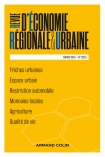
Revue d'économie régionale & urbaine (3/2007)
Pour acheter ce numéro, contactez-nous
Recevez les numéros de l'année en cours et accédez à l'intégralité des articles en ligne.
L’intégration du développement durable dans les politiques urbaines a renouvelé l’intérêt porté à l’interaction entre la forme urbaine et la mobilité quotidienne. La théorie des « trois âges » de la ville constitue un cadre théorique pertinent pour interpréter cette interaction. L’objectif de l’article est de tester l’opérationalité de cette théorie à partir de la relation entre forme urbaine et choix modal pour six aires urbaines françaises au moyen de l’estimation de fonctions spline cubiques. Les résultats obtenus sont de trois ordres. D’abord, le constat d’une substitution de l’automobile aux modes « doux » (marche et transports en commun) avec l’éloignement du centre. Ensuite, celui d’un usage quasisystématique de l’automobile dans les communes les plus éloignées du centre ; l’hypothèse de « dépendance automobile » semble adaptée pour expliquer ce phénomène, comme le montre l’analyse du lien densité-choix modal pour un échantillon réduit. Ces deux premiers ensembles de résultats valideraient la théorie des « trois âges » de la ville. Enfin, le recours au travail à domicile se révèle croissant avec la distance au centre, suggérant l’émergence d’une « Ville Immobile », quatrième âge possible de la ville.
Taking into account sustainable development for urban planning has led to question the interaction between urban form and daily mobility. The theory of the « three types » of city establishes that the available transport technology is a force which shapes the city (Walking City, Transit City, and Automobile City). Such an hypothesis constitutes a pertinent theoretical framework to explain the relationship. This article seeks to test the operationality of the theory, by analyzing the urban form-modal choice links for six French metropolitan areas. The technique used is an estimation of cubic spline functions. The results are as following : first, there is a modal split from « soft » modes of travel (walking and transit) to the automobile as the distance to the city-centre increases. Second, automobile is almost systematically used in the most remote areas ; the hypothesis of « automobile dependence » is useful to explain such a phenomenon, as we show by the analysis of the interaction between urban density and modal choice. These results validate the theory of the « three types » of city. Finally, we note a positive relationship between teleworking and the distance to the city centre, suggesting the emergence of a fourth type of city : the « Motionless City ».
